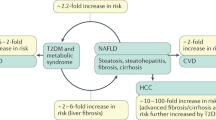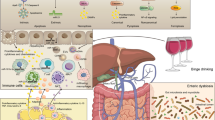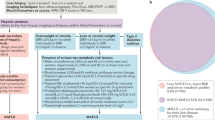Abstract
Nonalcoholic fatty liver disease (NAFLD) is associated with the metabolic syndrome. The metabolic syndrome is characterized by insulin resistance, which is produced by a complex interaction between genetic factors, macronutrient intake and lifestyle that alters the cytokine profile, cell biology and biochemical milieu of the liver, adipose tissue and striated muscle. The resultant disequilibrium in lipid homeostasis causes triglycerides to accumulate in the liver. An increase in oxidative stress, due to the generation of reactive oxygen species as a result of mitochondrial abnormalities and induction of the cytochrome P-450 system could be one mechanism by which the nonalcoholic fatty liver develops into nonalcoholic steatohepatitis. The pathogenesis of cytologic ballooning and Mallory body formation and their role in NAFLD remain to be defined. In addition, inflammation and fibrosis are likely to be secondary to hepatocyte injury and death.
This is a preview of subscription content, access via your institution
Access options
Subscribe to this journal
Receive 12 print issues and online access
$209.00 per year
only $17.42 per issue
Buy this article
- Purchase on Springer Link
- Instant access to full article PDF
Prices may be subject to local taxes which are calculated during checkout




Similar content being viewed by others
References
Grundy SM (1999) Hypertriglyceridemia, insulin resistance, and the metabolic syndrome. Am J Cardiol 83: 25F–29F
Diraison F et al. (2003) Contribution of hepatic de novo lipogenesis and reesterification of plasma non esterified fatty acids to plasma triglyceride synthesis during non-alcoholic fatty liver disease. Diabetes Metab 29: 478–485
Hallfrisch J (1990) Metabolic effects of dietary fructose. FASEB J 4: 2652–2660
Hellerstein MK et al. (1996) Regulation of hepatic de novo lipogenesis in humans. Annu Rev Nutr 16: 523–557
Roden M and Bernroider E (2003) Hepatic glucose metabolism in humans–its role in health and disease. Best Pract Res Clin Endocrinol Metab 17: 365–383
Pilkis SJ and Granner DK (1992) Molecular physiology of the regulation of hepatic gluconeogenesis and glycolysis. Annu Rev Physiol 54: 885–909
Saltiel AR and Kahn CR (2001) Insulin signalling and the regulation of glucose and lipid metabolism. Nature 414: 799–806
Magana MM and Osborne TF (1996) Two tandem binding sites for sterol regulatory element binding proteins are required for sterol regulation of fatty-acid synthase promoter. J Biol Chem 271: 32689–32694
Sato R et al. (1999) Sterol regulatory element-binding protein negatively regulates microsomal triglyceride transfer protein gene transcription. J Biol Chem 274: 24714–24720
Shimano H (2001) Sterol regulatory element-binding proteins (SREBPs): transcriptional regulators of lipid synthetic genes. Prog Lipid Res 40: 439–452
Mater MK et al. (1999) Sterol response element-binding protein 1c (SREBP1c) is involved in the polyunsaturated fatty acid suppression of hepatic S14 gene transcription. J Biol Chem 274: 32725–32732
Muller-Wieland D et al. (2001) Insulin-regulated transcription factors: molecular link between insulin resistance and cardiovascular risk factors. Int J Obes Relat Metab Disord 25 (Suppl 1): S35–S37
Stoeckman AK et al. (2004) Mlx is the functional heteromeric partner of the carbohydrate response element-binding protein in glucose regulation of lipogenic enzyme genes. J Biol Chem 279: 15662–15669
Willy PJ et al. (1995) LXR, a nuclear receptor that defines a distinct retinoid response pathway. Genes Dev 9: 1033–1045
Glass CK and Rosenfeld MG (2000) The coregulator exchange in transcriptional functions of nuclear receptors. Genes Dev 14: 121–141
Yoshikawa T et al. (2001) Identification of liver X receptor–retinoid X receptor as an activator of the sterol regulatory element-binding protein 1c gene promoter. Mol Cell Biol 21: 2991–3000
Desvergne B and Wahli W (1999) Peroxisome proliferator-activated receptors: nuclear control of metabolism. Endocr Rev 20: 649–688
Devchand PR et al. (1996) The PPAR alpha-leukotriene B4 pathway to inflammation control. Nature 384: 39–43
Poirier H et al. (2001) Differential involvement of peroxisome-proliferator-activated receptors alpha and delta in fibrate and fatty-acid-mediated inductions of the gene encoding liver fatty-acid-binding protein in the liver and the small intestine. Biochem J 355: 481–488
Maeda N et al. (2001) PPAR gamma ligands increase expression and plasma concentrations of adiponectin, an adipose-derived protein. Diabetes 50: 2094–2099
Costet P et al. (2000) Sterol-dependent transactivation of the ABC1 promoter by the liver X receptor/retinoid X receptor. J Biol Chem 275: 28240–28245
Bocher V et al. (2002) PPARs: transcription factors controlling lipid and lipoprotein metabolism. Ann NY Acad Sci 967: 7–18
Chitturi S et al. (2002) NASH and insulin resistance: Insulin hypersecretion and specific association with the insulin resistance syndrome. Hepatology 35: 373–379
Reaven GM (1988) Banting Lecture 1988: Role of insulin resistance in human disease. Diabetes 37: 1595–1607
Evans RM et al. (2004) PPARs and the complex journey to obesity. Nat Med 10: 355–361
Sanyal AJ et al. (2001) Nonalcoholic steatohepatitis: association of insulin resistance and mitochondrial abnormalities. Gastroenterology 120: 1183–1192
Schwarz JM et al. (2003) Hepatic de novo lipogenesis in normoinsulinemic and hyperinsulinemic subjects consuming high-fat, low-carbohydrate and low-fat, high–carbohydrate isoenergetic diets. Am J Clin Nutr 77: 43–50
Park J et al. (1997) Chronic exogenous insulin and chronic carbohydrate supplementation increase de novo VLDL triglyceride fatty acid production in rats. J Lipid Res 38: 2529–2536
Xu A et al. (2003) The fat-derived hormone adiponectin alleviates alcoholic and nonalcoholic fatty liver diseases in mice. J Clin Invest 112: 91–100
Yu S et al. (2003) Adipocyte-specific gene expression and adipogenic steatosis in the mouse liver due to peroxisome proliferator-activated receptor gamma1 (PPARgamma1) overexpression. J Biol Chem 278: 498–505
Charlton M et al. (2002) Apolipoprotein synthesis in nonalcoholic steatohepatitis. Hepatology 35: 898–904
Contos MJ and Sanyal AJ (2002) The clinicopathologic spectrum and management of nonalcoholic fatty liver disease. Adv Anat Pathol 9: 37–51
Day CP and James OF (1998) Steatohepatitis: a tale of two “hits”? Gastroenterology 114: 842–845
Weltman MD et al. (1998) Hepatic cytochrome P450 2E1 is increased in patients with nonalcoholic steatohepatitis. Hepatology 27: 128–133
Chavin KD et al. (1999) Obesity induces expression of uncoupling protein-2 in hepatocytes and promotes liver ATP depletion. J Biol Chem 274: 5692–5700
Crespo J et al. (2001) Gene expression of tumor necrosis factor alpha and TNF–receptors, p55 and p75, in nonalcoholic steatohepatitis patients. Hepatology 34: 1158–1163
Robertson G et al. (2001) Nonalcoholic steatosis and steatohepatitis. II. Cytochrome P-450 enzymes and oxidative stress. Am J Physiol Gastrointest Liver Physiol 281: G1135–G1139
Sumida Y et al. (2003) Serum thioredoxin levels as a predictor of steatohepatitis in patients with nonalcoholic fatty liver disease. J Hepatol 38: 32–38
Younossi ZM et al. (1999) Hepatic iron and nonalcoholic fatty liver disease. Hepatology 30: 847–850
Cenni V et al. (2003) Targeting of the Akt/PKB kinase to the actin skeleton. Cell Mol Life Sci 60: 2710–2720
Tobe K et al. (2003) Cytoskeletal reorganization induced by insulin: involvement of Grb2/Ash, Ras and phosphatidylinositol 3–kinase signalling. Genes Cells 8: 29–40
Denk H et al. (2000) Mallory bodies revisited. J Hepatol 32: 689–702
Feldstein AE et al. (2004) Free fatty acids promote hepatic lipotoxicity by stimulating TNF-alpha expression via a lysosomal pathway. Hepatology 40: 185–194
Feldstein AE et al. (2003) Hepatocyte apoptosis and fas expression are prominent features of human nonalcoholic steatohepatitis. Gastroenterology 125: 437–443
Unger RH (2003) The physiology of cellular liporegulation. Annu Rev Physiol 65: 333–347
Kershaw EE and Flier JS (2004) Adipose tissue as an endocrine organ. J Clin Endocrinol Metab 89: 2548–2556
Wake K (1980) Perisinusoidal stellate cells (fat-storing cells, interstitial cells, lipocytes), their related structure in and around the liver sinusoids, and vitamin A–storing cells in extrahepatic organs. Int Rev Cytol 66: 303–353
Bissell DM et al. (2001) Transforming growth factor beta and the liver. Hepatology 34: 859–867
Acknowledgements
This work was supported in part from a grant from the National Institutes of Health.
Author information
Authors and Affiliations
Corresponding author
Ethics declarations
Competing interests
The author declares no competing financial interests.
Glossary
- INSULIN RESISTANCE
-
A metabolic state characterized by an impairment in the ability to clear glucose at a given plasma insulin concentration
- PEROXISOME
-
A single membrane organelle that is present in eukaryotic cells and is involved in β oxidation of very long chain fatty acids, bile acid, cholesterol, plasmalogen, amino acid synthesis and purine metabolism
- MICROSOME
-
A small vesicle that is derived from endoplasmic reticulum after homogenization of cells
- UBIQUITINYLATED
-
Covalent attachment of a small highly conserved protein (ubiquitin) to lysine residues of other proteins, thereby marking them for intracellular proteolytic destruction
- PROTEOSOMAL
-
Large protein complex in the cytosol with proteolytic activity that is responsible for degrading proteins that have been marked for destruction by ubiquitylation or by some other means
Rights and permissions
About this article
Cite this article
Sanyal, A. Mechanisms of Disease: pathogenesis of nonalcoholic fatty liver disease. Nat Rev Gastroenterol Hepatol 2, 46–53 (2005). https://doi.org/10.1038/ncpgasthep0084
Received:
Accepted:
Issue Date:
DOI: https://doi.org/10.1038/ncpgasthep0084
This article is cited by
-
Utility of traditional and non-traditional lipid indicators in the diagnosis of nonalcoholic fatty liver disease in a Japanese population
Lipids in Health and Disease (2022)
-
Uncarboxylated osteocalcin ameliorates hepatic glucose and lipid metabolism in KKAy mice via activating insulin signaling pathway
Acta Pharmacologica Sinica (2020)
-
Does the enterolactone (ENL) affect fatty acid transporters and lipid metabolism in liver?
Nutrition & Metabolism (2017)
-
GPR40 agonist ameliorates liver X receptor-induced lipid accumulation in liver by activating AMPK pathway
Scientific Reports (2016)
-
Glutamate dehydrogenase activator BCH stimulating reductive amination prevents high fat/high fructose diet-induced steatohepatitis and hyperglycemia in C57BL/6J mice
Scientific Reports (2016)



